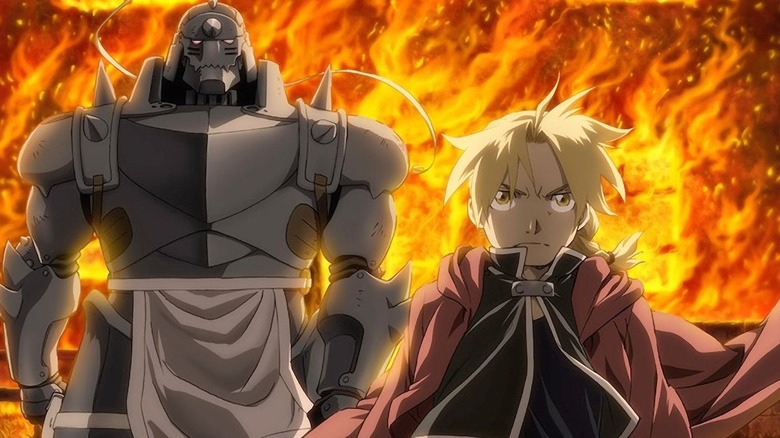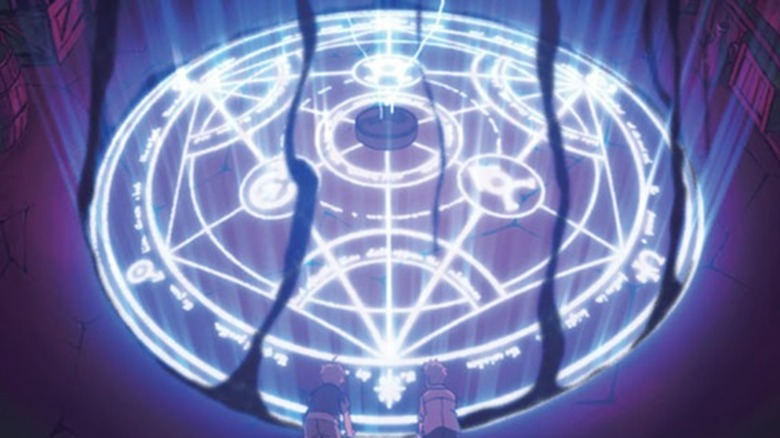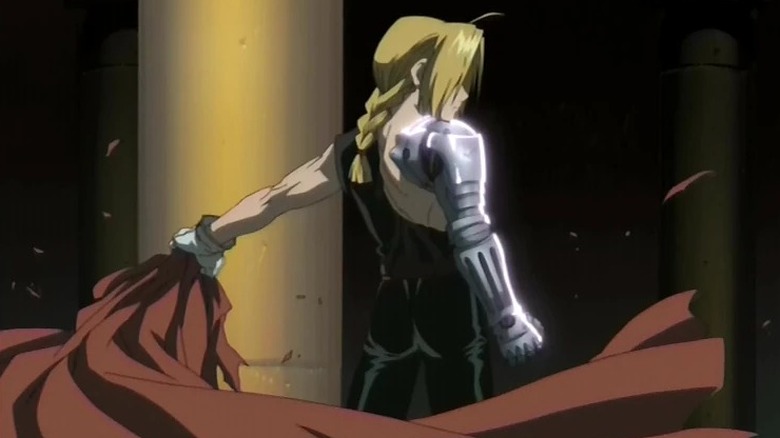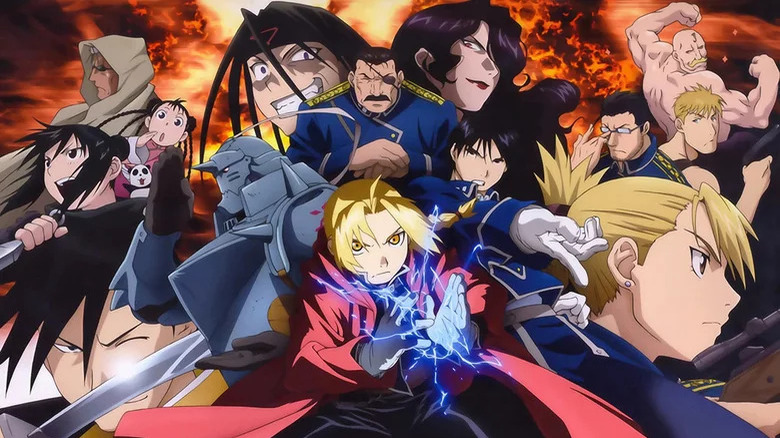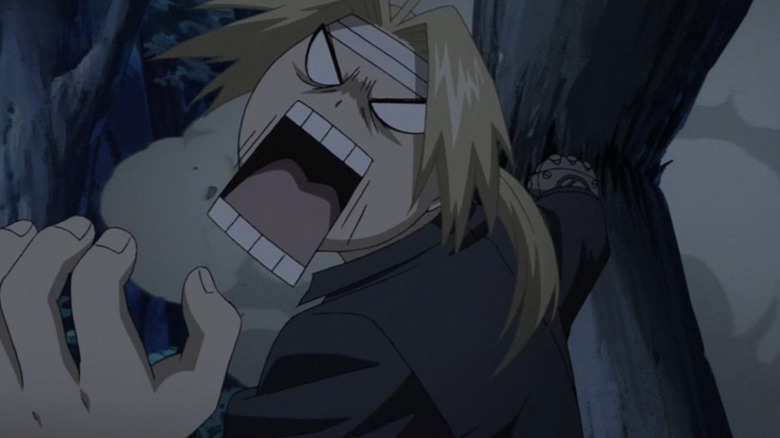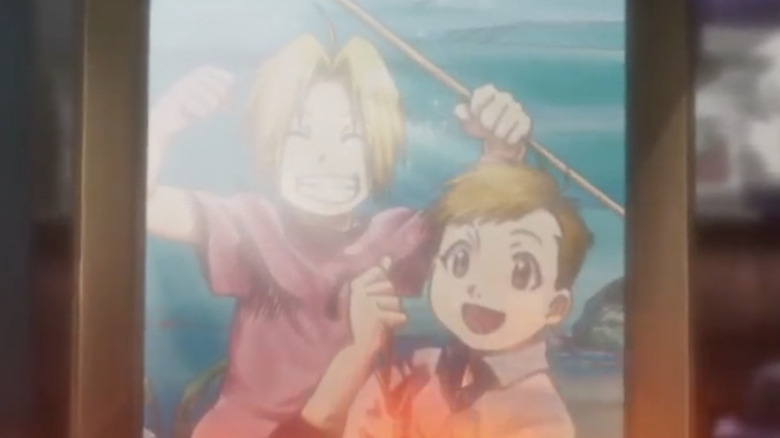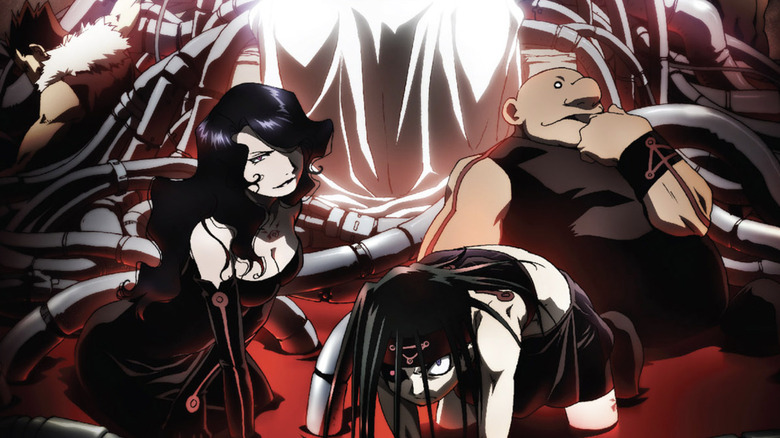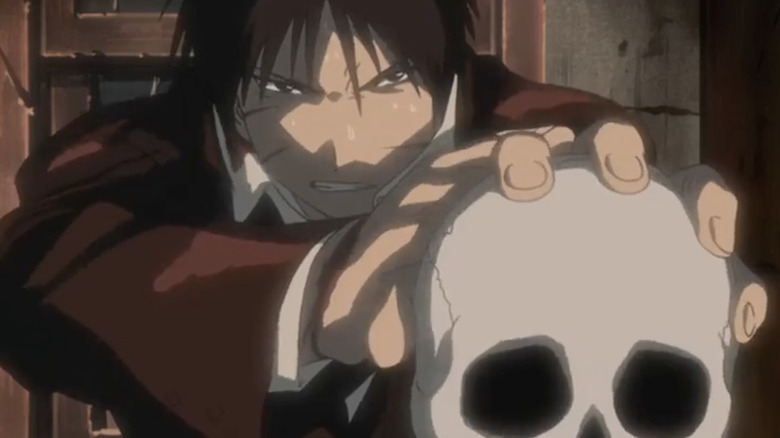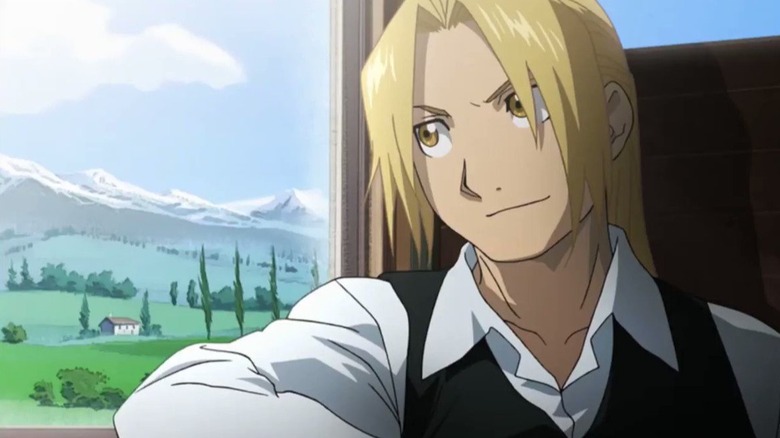How Studio Bones Made One Of The Best Anime Shows Ever – Twice
Japanese animation studio Bones celebrates its 25th anniversary this year; in commemoration, Crunchyroll assembled the documentary "Bones 25: Dreaming Forward." Broken into four chapters each about the length of an anime episode, the doc features talking head interviews with Bones staff/industry peers highlighting the studio's history and most famous projects.
"Dreaming Forward" doesn't scratch far past the surface, but that's not because it lacks material. In its 25 years, Bones has produced many beloved anime series; its current hit "My Hero Academia" is one of the most popular in the world. Long before that, though, Bones broke out by adapting Hiromu Arakawa's steampunk-action manga "Fullmetal Alchemist."
Set during a fictionalized 20th century in the European-esque country Amestris, the manga centers on two alchemist brothers: Edward Elric and Alphonse Elric. When they were young children, the Elrics lost their mother, Trisha, so they tried to transmute her back to life. Like any ill-advised science experiment, it failed; Ed lost an arm and leg, while Al's whole body was disintegrated (Ed bound his soul to a suit of armor). Now the brothers are searching for the Philosopher's Stone, which they think can make their bodies whole again. Bumps in the road of their adventures include dangerous priests, a military dictatorship, human-beast chimeras, and evil homunculi.
"Fullmetal Alchemist" began publication in 2001 and concluded in 2010. In that time span, Bones made it into an anime — twice, first in 2003 and then again in 2009 (as "Fullmetal Alchemist: Brotherhood"). The two "Fullmetal Alchemist" anime are quite different, but both earned acclaim and brought Bones into the anime big leagues.
How Studio Bones first made anime
The story of Bones begins at anime studio Sunrise, the home of "Gundam" and "Cowboy Bebop."
In the late 1990s, three Sunrise animation staffers — Masahiko Minami, Toshihiro Kawamoto, and the late Hiroshi Ōsaka — were working on "Cowboy Bebop." As Minami recounts in "Dreaming Forward," they felt most anime at the time was made to sell toys (even if "Bebop" director Shinichirō Watanabe elevated the project above a cash grab). So, they decided to split off and form their own studio. They named it "Bones" both because of how "barebones" the operation initially was and in reference to an old song called "Love Me to the Bone."
Some of Bones' earliest work was helping Sunrise on the "Cowboy Bebop" movie in 2001, but the founders wanted to tell original stories too. Bones' first original TV anime was 2000's "Hiwou War Chronicles," followed by the mecha show "RahXephon." They didn't subsist only on original projects though; in between those two series, they adapted the manga "Angelic Layer" into a 26-episode anime.
"Our experience creating original series makes it easier for us to understand the intentions of the authors [when adapting their work]," Minami argues in "Dreaming Forward." That definitely proved true when they first adapted "Fullmetal Alchemist."
How Bones discovered Fullmetal Alchemist
Bones' staffers, including future "Fullmetal Alchemist" character designer Yoshiyuki Ito, discovered Arakawa's manga earlier in its run and brought it to Minami's attention. Once he saw it, he "knew [he] wanted to animate it." So, Bones contacted Arakawa and her publisher ("Fullmetal Alchemist" ran in Square Enix magazine Monthly Shonen Gangan), securing a deal to make the manga into an anime.
Anime studios adapting in-progress manga series is normal practice. However, it's normally the publisher who spearheads this to stir up publicity for their series. Bones licensing "Fullmetal Alchemist" by their own initiative was totally backwards; the series didn't begin in-house, but it was as much a passion project as Bones' original series.
The "Fullmetal Alchemist" anime premiered on October 4, 2003, aired by the Mainichi Broadcasting System (MBS). At this point, there were only five volumes and about 20 chapters of the manga published (out of the eventual 108 chapters); nowhere near enough story for the 51 episodes that MBS had demanded. Series director Seiji Mizushima and screenwriter Shō Aikawa were in a pickle.
The go-to move in this situation was for an anime studio to make "filler" episodes, stalling time for the manga to catch up. You see this at Studio Pierrot, home of "Naruto" and "Bleach," which both have dozens of filler episodes. (In "Dreaming Forward," Pierrot President Michiyuki Honma says he's still frustrated that Bones got "Fullmetal Alchemist" before his studio could.)
Nowadays, most anime take seasonal breaks instead, but not in 2003. That meant, as Minami put it, Bones had to "essentially [create] an original anime."
The ending of Fullmetal Alchemist (2003) is original
The first half of "Fullmetal Alchemist" loosely adapts the then-published manga volumes. Without getting too deep into the weeds; it hits most of the same beats as the manga (and even recreates some moments shot-for-shot), but events are often stretched out or chronologically rearranged. After episode 25, the story keeps getting more and more different until the ending is unrecognizable from how the manga proceeded.
I'm not saying this as a criticism, though. The 2003 "Fullmetal Alchemist" is not a "Game of Thrones" season 8-style disaster; the second half of the story remains consistent with the characters and world established in the first. If "Fullmetal Alchemist" had crashed and burned once it ran out of source material, it wouldn't have become the popular (and unexpected, by Bones themselves) hit it did in both Japan and America.
Arakawa wasn't directly involved in the anime's production (Mizushima claims in "Dreaming Forward" that he's the only staff member who directly met with her), but she approved of the work they did. Between that and the anime's success, it makes total sense that she trusted Bones with her baby again. "Fullmetal Alchemist: Brotherhood" ran from 2009 to 2010 as the final chapters of the manga were published. It was still produced by Bones, but with a different team than the first series.
Fullmetal Alchemist: Brotherhood leaps and soars
Speaking to Anime News Network in 2017, "Brotherhood" director Yasuhiro Irie said he was aware of how popular the first series and manga were when he accepted the job, but didn't let that shape how he approached it. Plus, his job would be easier than Mizushima's was since he started with a full road map.
"Instead of saying that there wasn't much creative freedom, I'd rather say the standard was basically just the manga. That was sort of like the Bible for the whole thing; all the meetings and the whole process was about figuring out how best to convert the manga into anime."
It's clear both series had different production teams just from a cursory look at them. Compared to the 2003 series, "Brotherhood" has fairly even lighting, a brighter base color palette, rounder edges on the character's pencil lines, and more fluid character animation. It also incorporates touches of CGI, particularly when it comes to portraying the green monster form of the homunculus Envy.
The 2003 series renders the same scenes with greater stylized touches, relying on lighting choices that simply wouldn't be possible in black-and-white manga panels. It also uses camera techniques that only a motion medium can. When Ed confronts the villainous Dante in episode 49, "The Other Side of the Gate," their conversation is shown with a 360 degree spinning shot. Later shots of Ed, who's losing his composure, feature fish-eye lens effects and a dolly zoom.
If I had to be simplistic about it: the 2003 "Fullmetal Alchemist" is better directed, while "Brotherhood" is better animated.
Why Fullmetal Alchemist: Brotherhood is not rushed
Despite their different approach compared to the first anime, Irie and his team succeeded and created a show even more beloved than the 2003 series. "Fullmetal Alchemist: Brotherhood" has some of the best action I've ever seen in an anime, but no less emotional punch.
Now, to clear up some misconceptions: "Brotherhood" is not a remake of the 2003 "Fullmetal Alchemist." Saying so is like calling "The Dark Knight" a remake of the 1989 "Batman" film. Some fans (mostly those who started with the 2003 "Fullmetal Alchemist") also allege that the opening episodes of "Brotherhood" are rushed in comparison to the original anime, or that the "Brotherhood" team even purposely skipped over the early chapters to get to the unadapted parts.
This is not true, but it's a convincing urban legend. I assumed this was the case because I'd seen it repeated so often, but then I read the manga and found it lines up much better with "Brotherhood," even early on. Really, the truth is the opposite; the 2003 "Fullmetal Alchemist" is stretched out — but not necessarily for the worse.
Making Fullmetal Alchemist more emotional
The first opportunity that the 2003 "Fullmetal Alchemist" seized was deepening the series' central brotherly relationship. Mizushima recounts in "Dreaming Forward" as such:
"I spoke with Aikawa about depicting their relationship more carefully or deeply at the start of the anime. We reduced their starting ages by a couple of years [...] [H]ow would kids that age feel being burdened by something like [the Elrics' past]? In the manga, the brothers have already steeled their resolve, so we wanted to show how they reached that point in the anime."
The anime begins with two episodes adapting the manga's first two chapters, but then in episode 3, "Mother," flashes back to the Elrics' childhood (something the manga saved for later), showing their happy days before Trisha died, and how they committed the "ultimate taboo." The series then continues from there, chronicling how Ed became a State Alchemist (a "dog of the military") to get the resources he and Al needed; he trades his innocence to help his brother. The anime then only catches up with the "present day" in episode 10, "The Phantom Thief."
The best way the 2003 "Fullmetal Alchemist" expands on the manga is the story's most shocking moment. In chapter 5, the Elrics befriend the young girl Nina Tucker, daughter of chimera-creating alchemist Shou Tucker — until her father uses her as one of his experiments. The anime stretches this single chapter into two episodes, building up the dread before it climaxes in episode 7, "Night of the Chimera's Cry." Both the audience and Elrics bond with Nina more, making her fate all the more crushing. Having it happen in the Elrics' backstory (when they're only 12 and 11) also adds weight to their characters.
The villains of Fullmetal Alchemist are the sins of man
"Fullmetal Alchemist" episode 13, "Fullmetal vs Flame," adapts a bonus chapter of the manga ("The Military Festival") where Edward and his superior officer, Colonel Roy Mustang, face off in a stunt match. In the manga, this is just a hero vs. hero slug match like you might see in Marvel Comics. The anime, on the other hand, uses it to deepen the two alchemists' relationship; Mustang freezes up during the fight with a PTSD flashback from his war service, and you understand he mentors Ed because he wants to keep the boy on the right path.
Once the 2003 "Fullmetal Alchemist" anime goes off on its own, it still uses the ideas from the manga, sometimes ingeniously linking them together. The Philosopher's Stone remains the central driving force of the narrative and essential to the villains' plans, whereas it turned out to be more incidental in the manga and "Brotherhood."
The anime also wisely ties the villains closer to the heroes' backstory. In the 2003 anime, the homunculi are the result of alchemists trying to raise dead loved ones with human transmutation — Sloth is the facsimile of Trisha that Ed and Al made in the series' first scene. This change makes these Seven Deadly Sins-coded villains so much more while still presenting them as the personification of humanity's faults.
In the 2003 series, though, those sins reside closer to our heroes' hearts.
Fullmetal Alchemist: The Sins of Edward Elric
Edward Elric walks in the same footsteps as Icarus and Victor Frankenstein; he meddled with the laws of nature and got burnt. In every version of the story, one of his first scenes is him ridiculing a religious girl for believing in God, telling her that science and alchemy hold answers to the world's mysteries, not prayer. This point, and the direction Ed's character goes on, reflects larger thematic differences.
In "Brotherhood" and the manga, Edward's sin is simple pride; he thought he could solve everything, even death, but by the series' end he learns humility. The homunculi he's most contrasted with is Pride, who has the body of a child. The penultimate episode of "Brotherhood" has Ed and Father, the homunculi's creator, both stand before the Truth (the closest thing in this universe to God). Ed accepts he's made mistakes and earns Truth's approval, while Father is still unable to recognize his.
In the 2003 "Fullmetal Alchemist," Ed's flaw is more his refusal to grow (fitting since the show overall makes the brothers more immature). The story constantly tears down his naive assumptions about the world, from his belief that he can avoid killing his foes to thinking that "war is something that happened in a far off land where I couldn't see it," to his childish notion that his dreams matter most. That's why the homunculus embodying his sin in this version is Sloth, i.e. a refusal to advance.
Roy Mustang's journey in Fullmetal Alchemist
There's a similar divergence in how the two narratives of "Fullmetal Alchemist" present Colonel Mustang. Roy's backstory is the same; as the "Flame Alchemist" of Amestris, he participated in a genocidal campaign against the nation of Ishval. Burdened by guilt, he seeks to climb the ranks of the military to turn Amestris into a better place and atone for the innocent lives he took.
The manga and "Brotherhood" don't frame this quest as selfless, but Mustang's right hand Riza Hawkeye argues it is his duty; Edward ultimately agrees and decides he'll be a check on Mustang with her. The series leaves Mustang's future uncertain, but it's suggested he'll eventually become Führer of Amestris and right the wrongs of the past regime, including his own.
In the 2003 anime, Roy Mustang's quest to become Führer is more about living with his own guilt; he tells himself he can make things right because otherwise he can't keep going. Notably, he admits his goal is less about reform and more about ensuring that he'll never have to follow unjust orders again (because he'll be the one giving them). In this iteration, he decides the wheels of justice spin too slowly and, after learning Amestris Führer Bradley is a homunculus, assassinates him (and tellingly discards his military uniform before doing so).
In episode 48, "Goodbye," Ed and Roy share a final conversation about their own naivete and the former distills their shared realization: "Even when our eyes are closed, there's a whole world out there that lives outside ourselves and our dreams."
Equivalent Exchange in Fullmetal Alchemist
In "Fullmetal Alchemist," alchemy is governed by "equivalent exchange" — you can only create by sacrificing something else. Arakawa grew up on a dairy farm, and this philosophy emerges from her background in agriculture; you can only cultivate produce by nurturing it. Arakawa thinks there's a natural order to the world, and to reshape it, her alchemist characters must understand that all is one, one is all.
In the 2003 series, equivalent exchange is presented instead as just another false philosophy, one that people like Ed and Mustang believe in to give meaning to an unfair world. Dante throws all the ways that equal effort does not result in equal gain in Edward's face. Ed's clinging to the idea is another example of how he can't grow up; he clings to a simplistic black and white way of thinking and uses equivalent exchange as a guide because it affirms that his suffering and decisions will have meaning in the end.
"Brotherhood" and the manga end with Ed giving a voiceover narration declaring, "There's no such thing as a painless lesson," affirming the idea of equivalent exchange. In the 2003 anime, Al closes out the series instead, saying equivalent exchange is an imperfect ideal. The two "Fullmetal Alchemist" anime complement each other by posing the same questions and then offering different answers, which is why both stand up as two masterful series in their own right.
Thanks to their exemplary work on "Fullmetal Alchemist," Bones continues to be one of Japan's top animation studios. "Dreaming Forward" mentions how offers for manga adaptations flowed in once "Fullmetal Alchemist" proved Bones' chops, and haven't stopped since. Sounds like an equivalent exchange to me.
